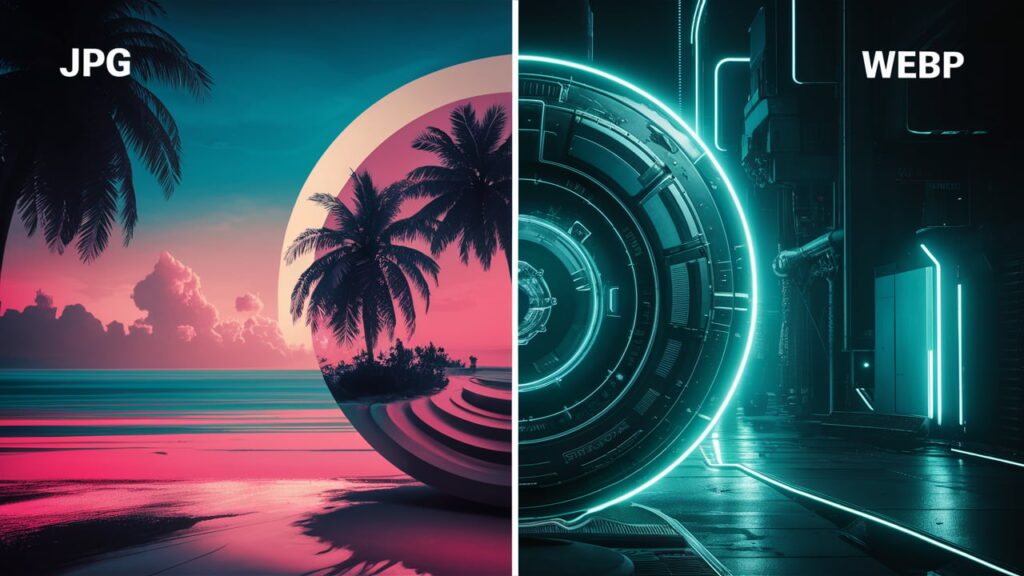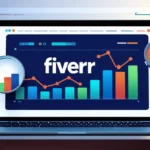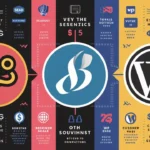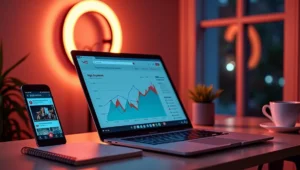JPG Vs WebP
Have you ever wondered why pictures on websites or apps load so quickly or slowly? Well, it all depends on the type of image file used. The most common image formats are JPG and WebP. These are the files that hold your pictures, but they work in different ways.
- JPG
- WebP
- WebP vs JPG: Key Differences
- 💖 You Might Also Like
- SEO and Performance Benefits of WebP
- ✨ More Stories for You
- When Should You Use JPG?
- How to Convert JPG to WebP
- 🌟 Don’t Miss These Posts
- Should You Switch to WebP in 2025?
- Conclusion
- FAQ (Frequently Asked Questions)
- What’s the difference between JPG and WebP?
- Which one is better, JPG or WebP?
- Can I use WebP images on my website?
- How do I change my JPG images to WebP?
- Is WebP good for mobile websites?
- Should I switch to WebP in 2025?
In this article, we are going to talk about two popular image formats: JPG and WebP. We will compare them and help you decide which one is better for you, especially in 2025.
JPG
JPG (pronounced as “jay-peg”) is one of the most popular image formats used on the internet today. It stands for Joint Photographic Experts Group, but you don’t need to worry about the long name. Just think of it as a way to store pictures on your phone or computer.
JPG images are great for photos because they can be saved in a smaller size. This means they don’t take up too much space on your device or website. But, to make the picture smaller, JPG images lose some of their quality. You might notice that some details are not as sharp or clear in JPG images compared to other formats.
People use JPG because it’s easy to share, looks good enough for most things, and works on almost any device or browser. So, when you take a picture on your phone or camera, it’s likely to be in JPG format!
WebP
WebP is a newer type of image format created by Google. Just like JPG, WebP stores pictures, but it works a little differently. The best part about WebP is that it makes pictures smaller without losing much quality. This means you can have pictures that look good but take up less space on your phone, computer, or website.
WebP is special because it helps websites load faster. When a website uses WebP images, the page can open quicker, which makes it better for people visiting your site. Even though WebP images are small, they still look sharp and clear, just like the original picture.
Not every device or browser supports WebP yet, but it’s becoming more popular. Many websites and apps are switching to WebP because it helps save space and make things run faster. If you want your images to look great and your website to load quickly, WebP is a fantastic choice!
WebP vs JPG: Key Differences
Now, let’s look at the big differences between WebP and JPG. These two image formats do the same thing – store pictures – but they do it in different ways. Let’s break it down:
1. Picture Size:
- JPG: JPG pictures are small, but they can still take up a lot of space if the picture is big or detailed.
- WebP: WebP images are smaller than JPG images, but they still look great! So, WebP helps save space on your phone or website.
2. Quality of the Picture:
💖 You Might Also Like
- JPG: JPG pictures can lose some of their details to become smaller in size. Sometimes, the picture might look blurry or less sharp.
- WebP: WebP keeps most of the picture’s details, even though it is smaller. This means WebP images usually look clearer and sharper than JPG images.
3. Speed:
- JPG: JPG images are okay for websites, but they can slow things down, especially if there are a lot of them.
- WebP: WebP images help websites load faster because they are smaller and don’t take up much space.
4. Compatibility:
- JPG: JPG works on almost any device, browser, or app. It’s very common and easy to use everywhere.
- WebP: WebP is not as old as JPG, so it might not work on every device or browser yet. But more and more websites are starting to use it.
differences between JPG and WebP:
| Feature | JPG | WebP |
|---|---|---|
| File Size | Larger file size | Smaller file size |
| Image Quality | Lossy compression, quality drops | Lossy or lossless, better quality |
| Speed of Loading | Slower loading on websites | Faster loading on websites |
| Support Across Browsers | Supported by all browsers | Supported by most modern browsers |
| Mobile-Friendly | Works on mobile devices | Works better on mobile devices |
| SEO Benefits | Limited SEO benefits | Improves SEO due to faster speed |
| Transparency | No transparency support | Supports transparent backgrounds |
| Animation Support | No animation support | Supports animated images (like GIFs) |
| Compression Type | Lossy compression | Lossy and lossless compression |
| File Types Supported | Only for photos | Works for photos, illustrations, and even vector images |
| Popularity | Very popular, widely used | Gaining popularity, not as common |
| Image Detail | Can lose details when compressed | Keeps more detail and sharpness |
| Use on Websites | Works but slows website loading | Helps speed up website loading |
| Image Editing Flexibility | Less flexibility in editing | More flexibility with better quality retention |
| Compatibility with Old Devices | Works with older devices and software | May not be supported on very old devices or software |
So, if you want faster websites and clearer pictures, WebP is a great choice! But, if you need a format that works almost everywhere without any problems, JPG is still a solid option.
SEO and Performance Benefits of WebP
When you create a website, you want it to be fast and easy for people to visit. But did you know that the images on your website can affect how fast it loads? That’s where WebP comes in! Let’s see how WebP can help your website perform better and improve your SEO (Search Engine Optimization), which means helping your site show up higher on search engines like Google.
1. Faster Website Speed:
WebP images are smaller than JPG images. This means your website can load faster! When your website opens quickly, visitors don’t have to wait, and they are more likely to stay on your site. Faster websites are also liked by Google, so your site might rank better in search results.
2. Better User Experience:
When people visit a website, they want things to work fast and smoothly. If your images take a long time to load, people might leave your website. WebP helps make your website faster and smoother, which makes visitors happy. And happy visitors are more likely to visit again!
3. Saving Bandwidth:
WebP images use less data compared to JPG images. This means your website will use less bandwidth (the amount of data needed to load your site). This is especially helpful for people using mobile data or slower internet connections.
4. Improved SEO:
Google loves websites that are fast and provide a good user experience. When you use WebP images to make your site faster, Google can rank your website higher. This means more people will find your site when they search for something online. So, using WebP can help you get more visitors and grow your website!
In short, WebP is not only great for saving space and improving image quality, but it also makes your website faster and better for SEO, helping you get more people to visit and stay on your site.
✨ More Stories for You
When Should You Use JPG?
While WebP is great for many websites, there are times when JPG might be a better choice. Let’s see when you should still use JPG for your pictures:
1. For Simple Photos:
JPG is perfect for regular photos, like pictures of your family, friends, or landscapes. If you take a photo with your camera or phone, it’s probably saved as a JPG. It works really well for photos that don’t need to be too detailed.
2. If You Need Universal Compatibility:
Not all devices or web browsers support WebP yet. But JPG works almost everywhere! If you want to make sure your image shows up on all devices and browsers, JPG is a safe choice.
3. When File Size Doesn’t Matter Too Much:
If you don’t mind your images being a bit bigger in size and your website isn’t too slow, JPG is fine. JPG keeps a good balance between image quality and file size, so if speed isn’t your main concern, you can stick with JPG.
4. For Websites That Don’t Need Super Fast Speed:
If your website isn’t focused on super-fast loading times or high-quality images, JPG can still work well. It’s a classic format that people have been using for years, and it’s still good for many simple websites.
In short, use JPG for regular photos, when you need your images to be seen everywhere, and when speed or file size isn’t the most important thing. While WebP is great for many reasons, JPG is still a solid and reliable choice for certain situations!
How to Convert JPG to WebP
If you want to make your website faster and your images smaller, you might want to convert your JPG pictures into WebP. Don’t worry! It’s super easy to do. Here’s how you can convert your JPG images to WebP:
1. Use an Online Converter:
There are many free websites that can help you change JPG to WebP. You don’t need to download anything! Just follow these steps:
- Go to a website like Convertio or Online-Convert.
- Click on the button that says “Choose File” or “Upload.”
- Select your JPG image from your computer or phone.
- After the image uploads, choose WebP as the format you want to convert to.
- Click on Convert and wait a few seconds for the website to change the file.
- Once it’s ready, download the new WebP image!
2. Use an Image Editor (Like Photoshop):
If you have an image editor like Photoshop, you can easily convert JPG to WebP:
🌟 Don’t Miss These Posts
- Open your JPG picture in Photoshop.
- Click on File, then choose Save As.
- From the list of formats, pick WebP.
- Save the image, and now you have a WebP version of your JPG!
3. Use a Converter App (For Phones):
If you’re using a phone and want to convert a JPG to WebP, you can find apps in the App Store (for iPhone) or Google Play (for Android). Search for “JPG to WebP converter” and follow the easy steps in the app.
Should You Switch to WebP in 2025?
Now that you know about JPG and WebP, you might be wondering, “Should I switch to WebP in 2025?” Well, let’s look at why 2025 might be a great time to start using WebP for your pictures.
1. Faster Websites = Happier Visitors:
In 2025, speed is more important than ever. People want websites to open quickly, and WebP helps make that happen. Because WebP images are smaller, they load faster, which means faster websites. If you want to keep your visitors happy and stop them from leaving because of slow loading, WebP is a great choice.
2. Google Loves Fast Websites:
Google wants to show people the best, fastest websites. If your website loads faster with WebP images, there’s a good chance Google will rank your site higher in search results. So, using WebP might help more people find your website!
3. WebP is Becoming More Popular:
In 2025, more and more websites are using WebP. Even though WebP didn’t work on all devices and browsers a few years ago, now it’s supported on almost everything! This means you can use WebP without worrying too much about it not showing up on some phones or browsers.
4. WebP is Great for Mobile Devices:
Many people browse the internet on their phones today. WebP is especially good for mobile devices because it saves space and helps websites load faster on smaller screens. If your website has a lot of visitors from phones, WebP is even more useful!
Summary:
In 2025, switching to WebP can help your website be faster, better for SEO, and more mobile-friendly. If you want to make your website the best it can be, switching to WebP is a smart move!
Conclusion
So, now that we’ve talked about JPG and WebP, here’s a quick summary to help you decide which one to use.
- JPG is great for photos and works on almost every device and browser. But, it can make your website slower and might not always look the best.
- WebP is a newer image format that makes your pictures smaller and helps websites load faster. It’s becoming more popular and is great for SEO (making your website show up higher on Google) and better user experience.
In 2025, WebP is a smart choice if you want your website to be faster and easier to use. It’s especially good for websites with lots of images or visitors on mobile phones.
If you want the best pictures for your website and you care about speed, switching to WebP is a great idea! But, if you need something that works everywhere, JPG will still do the job.
Choose the right format based on what you need, and your website will be even better!
FAQ (Frequently Asked Questions)
Here are some common questions people have about JPG and WebP.
What’s the difference between JPG and WebP?
JPG is a common image format that works almost everywhere. It’s good for photos but can lose some quality to make the file smaller.
WebP is a newer format that makes images smaller without losing much quality. It’s great for websites because it helps them load faster.
Which one is better, JPG or WebP?
WebP is better if you want faster website speeds and clear images. But, JPG works fine for basic photos and is supported by almost everything.
Can I use WebP images on my website?
Yes! WebP works on most modern devices and browsers. It’s getting more and more popular, so it’s a good choice for your website.
How do I change my JPG images to WebP?
You can easily convert JPG to WebP using online tools, image editors like Photoshop, or apps on your phone. Just upload your JPG, choose WebP as the format, and you’re done!
Is WebP good for mobile websites?
Yes, WebP is great for mobile websites! It helps pages load faster on phones, saving space and making the browsing experience better.
Should I switch to WebP in 2025?
Yes! In 2025, using WebP will help make your website faster and more SEO-friendly. It’s a smart choice if you want to improve your site and get better results on Google.















